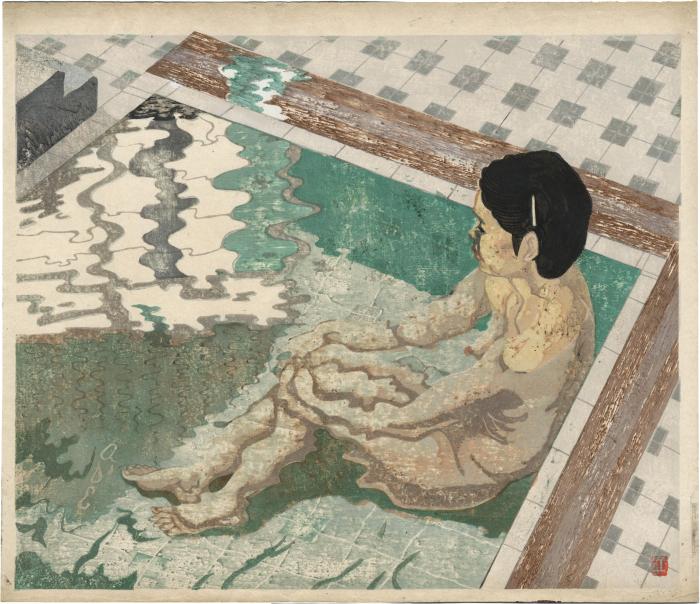Sekino Jun'ichirō (関野準一郎) (artist 1914 – 1988)
Woman soaking in a bath - The Bather (浴婦)
ca 1943
Toki-no-Wasuremono Gallery - similar print by Ishii Tsuruzō from 1921
Los Angeles County Museum of Art - dated to 1943 Unsigned and undated. There is the artist's seal in red in the lower right corner. Also, there appears to be seals in the right border which have been abraded and are therefore unreadable.
****
There are considerable differences between the print in the Lyon Collection and that of the copy in the collection of the Los Angeles County Museum of Art: 1) the colors of the copy in Los Angeles are much stronger, more saturated. Of course, the muted colors of those in the Lyon Collection make sense, too, because it evokes the sense of steam in a hot bath house; the color of the woman's right nipple is much redder than that of the one shown here; the ripples in the water in the LACMA print are far more pronounced, making it look like the pieces in a jigsaw puzzle; there are more colors under the water, including both the use of turquoise colored tiles and what appears to be a yellow and purple cloth on the bottom of the pool to the woman's right; in the Los Angeles example the woman seems to be wearing an arced light purple headband, while in the print in the Lyon Collection it is not as pronouncedly arced, is whitish and looks more like a hairpin; and the wooden border around the bath is more markedly reddish-brown. And 2) the example in Los Angeles has the date of Showa 18, i.e., 1943, printed on it in the lower right-hand corner along with the title, 'the Bather'.
****
The relationship between the Lyon Collection copy and the one shown by the Seattle Art League is interesting. The Lyon Collection print might be a proof printed before the final edition. Strengthening this argument is the fact the by comparing the one in the Lyon Collection and that of the Seattle group was printed with, at least, one less block than the Seattle sheet.
****
Sekino Jun'ichirō's art was greatly influenced by that of late 19th and early 20th century European art, especially that of Pierre Bonnard. In an Andon article written by John Fiorillo in November 2017, 'The art of Sekino Jun'ichirō: Expressive realism and geometric formalism' it says: "Comparing Sekino’s early mature woodcuts with works by western artists on similar themes reveals Sekino’s responses to the European avant-garde and brings into focus certain structural components in his compositions. Consider, for example, the French Post-Impressionist painter Pierre Bonnard (1867–1947), whose Nude against the light (1908...) portrays his lifetime companion and model Marthe de Méligny standing in a bathroom that vibrates with light, colour, and pattern. As daylight floods in through a diaphanous curtain, the space vibrates with chromatic modulations of a fluid reality."
One question we need to ask ourselves is how aware Sekino might have been of Bonnard's bathroom compositions from the1920s and 1930s showing his model Marthe in her bath? While they are not exactly like this print by Sekino where the woman is seated the overall effect is similar to Bonnard's bathing pictures. For both artists the woman's head is out of the water, while the rest of the body is submerged naturally.
****
There is an interesting passage about technique in John Fiorillo's wonderful article about Sekino from Andon 104 mentioned above. Whether it applies to this print or not, we can not say for sure, but even if it doesn't it gives a hint into the working process of this artist.
"By 1940 Sekino had already assimilated some essentials of Onchi’s hanga printmaking style, including ‘shallow carving’ (asa-buri浅彫リ) where a curved chisel is used to prepare blocks for printing gradations or soft edges in a painterly manner.27 Soft-edge printing was effective for the shading in human skin, textiles, wood grain, dappled or gradated colours, and textured surfaces."
self-printed (sōsaku hanga - 創作版画) (author)
